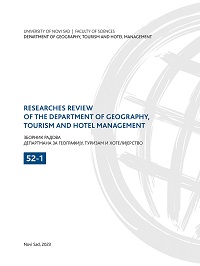ADAPTATION STRATEGIES OF SHEA AND AFRICAN LOCUST BEAN TREE MANAGERS IN AGRICULTURAL FIELDS IN A CONTEXT OF CLIMATIC VARIABILITY: A CASE STUDY FROM THREE REGIONS OF BURKINA FASO (WEST AFRICA)
ADAPTATION STRATEGIES OF SHEA AND AFRICAN LOCUST BEAN TREE MANAGERS IN AGRICULTURAL FIELDS IN A CONTEXT OF CLIMATIC VARIABILITY: A CASE STUDY FROM THREE REGIONS OF BURKINA FASO (WEST AFRICA)
Author(s): Isidore Pawendkisgou Yanogo, Joseph YaméogoSubject(s): Geography, Regional studies
Published by: Prirodno-matematički fakultet, Univerzitet u Novom Sadu
Keywords: Trees in agricultural fields; socioeconomic characteristics; adaptation strategies; shea and African locust; Burkina Faso
Summary/Abstract: Agricultural field trees constitute social nets for rural households in Burkina Faso. However, in recent decades they have been affected by climate variability, which has led to a significant reduction in the populations of dominant species such as shea and African locust within them. The objective of this study is therefore to determine the adaptation strategies developed by managers, as well as the factors influencing these strategies to cope with the changing environment. The methodology deployed for this purpose consists of primary and secondary data collection. Descriptive statistics and binary logistic regression were used to analyse the collected data. The study revealed that more than 70% of the tree managers are men and the majority of them are illiterate, with households of 5-15 children. In addition, more than 80% of the managers have agriculture as their main activity, and the size of their holdings is between 1ha and 10ha. Three strategies are used by tree managers in agricultural fields. The proactive strategy aims to anticipate the consequences of climate variability. The reactive strategy aims to react to the effects of climate variability. The strategy of silvicultural techniques consists of pruning, grafting and assisting the trees. However, the choice of strategies is influenced by the socio-economic characteristics of the respondents. For example, the proactive strategy is influenced by education level, household size and income from non-timber forest products. For the reactive strategy, the size of the holding and the level of education have an effect on the choice of strategy. For the silvicultural techniques strategy, age and education level have an impact on the choice of strategy. It is then up to the relevant authorities to work in the light of these results to initiate actions to strengthen the coping strategies of the people managing the trees in the agricultural fields.
Journal: Zbornik radova Departmana za geografiju, turizam i hotelijerstvo
- Issue Year: 52/2023
- Issue No: 1
- Page Range: 1-19
- Page Count: 19
- Language: English

